Gas Chromatography with Reduction Gas Detection for the Characterization of Parts- Per-Billion Levels of Ethylene in Various Matrices
LCGC North America
A highly sensitive and selective mercuric oxide–based reduction gas detector was successfully used for parts-per-billion level gas chromatography (GC) determination of ethylene in various matrices such as in the monitoring of fruit ripening, ambient air, and industrial solvents.
A highly sensitive and selective mercuric oxide–based reduction gas detector was successfully used for parts-per-billion level gas chromatography (GC) determination of ethylene in various matrices such as in the monitoring of fruit ripening, ambient air, and industrial solvents. Separation of ethylene from the sample matrix was achieved by isothermal analysis using a silica-based packed column. Backflushing was incorporated to ensure overall system cleanliness and to improve sample throughput, keeping analysis time under 4 min.
Reduction gas detection (RGD) was originally conceived as an ultratrace gas chromatography (GC) detection method for the measurement of carbon monoxide and hydrogen for the electronics industry. Compounds such as acetone, aldehyde, and olefins reduce mercuric oxide and elicit a respectable RGD response (1–8). Amongst the olefins, ethylene is industrially significant because it is one of the major building blocks for downstream products such as ethylene oxide, ethylene glycol derivatives, linear low density polyethylene, and high density polyethylene. Ethylene is found in the atmosphere at the parts-per-billion level from natural and anthropogenic sources. Ethylene is generated in nature by the metabolic activities of vegetation and microbes. Ethylene is also a by-product of combustion from sources such as motor vehicles, fires, and volcanic activities (9,10). From an emission perspective, ethylene can be generated through catalytic cracking of natural gas; thus, atmospheric emissions are monitored by regulatory agencies (11,12). Ethylene plays a role in agriculture such as impacting the quantity and quality of crop production, the shipping of fruits and vegetables, and fruit preservation to maximize the availability of food across seasons.
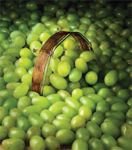
Headspace gas chromatography (GC) with flame ionization detection (FID) is one of the most popular approaches for trace ethylene measurement (13,14). However, headspace GC is limited by the amount of sample that can be reliably introduced into the analytical system. Dynamic enrichment, or trapping, is an alternative to headspace GC that has the advantage of concentrating the analytes to detectable levels, thereby reducing detection limits. Solutions of mercuric acetate or mercuric perchlorate have been used as nonspecific traps for olefins based on complexation. The addition of chloride salts to these solutions degrades these complexes and releases ethylene for headspace analysis (15). These methods suffer from low trapping efficiency, considerable sample preparation time, and the necessity of using toxic reagents. Thermal desorption technology combined with adsorbent trapping for light hydrocarbon analysis is another alternative, but substantially higher cost of ownership and high frequency of maintenance from trap contamination are key limitations (16).
In this article, a simple and reliable GC procedure with RGD was developed for the determination of ultratrace levels of ethylene in the fruit ripening process, in industrial solvents, and in ambient air monitoring.
Experimental
A Peak Performer 1 GC analyzer (Peak Laboratories) was used for all of the experiments. Figure 1 shows a block diagram of the GC system, which includes a rotary valve, a packed column, an RGD system, and an MnO2 catalyst (hopcalite) filter. Sampling and backflushing were conducted with A C10WP 10-port sample injection valve (Valco Instruments Co.) fitted with a 1-mL sampling loop.
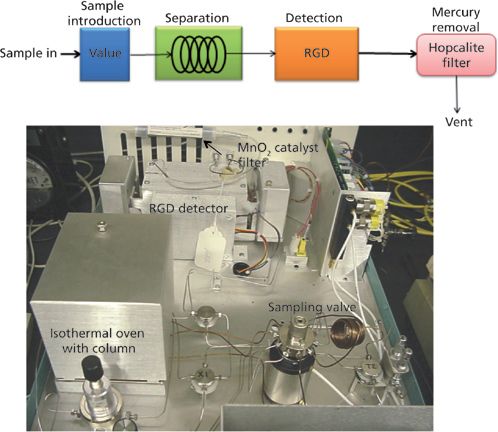
Figure 1: A block diagram of the analytical system.
Separation of ethylene was conducted with a 31 in. × 1/8 in. (79 cm × 0.32 cm) stainless steel column packed with Unibeads 3S, 60/80 mesh silica (Alltech Assoc.) at 130 °C using nitrogen carrier gas at 30 mL/min. A second column with dimensions of 16.5 in. × 1/8 in. (41.9 cm × 0.32 cm) with the same packing was used as a guard column. Backflushing was conducted 70 s after injection to isolate the detector from heavier hydrocarbon components and water and maintain a lower overall analysis time. These short columns were packed in-house.
The detector consists of a heated mercury oxide reaction bed, where Hg(II) is reduced to Hg(0) vapor by the analyte of interest. The reaction bed can be constructed from red or yellow mercury oxide, either granulated or powder sieved to a uniform particle size of approximately 40 μm, roughly spherical in shape. The reaction bed of this construction typically has a diameter of 0.063 in. and is 0.063 in. deep and contains approximately 20 mg of mercury oxide. The reaction bed requires minimal maintenance. A single charge lasts in excess of two years under normal operation conditions. Symptoms of a worn-out bed include a high background detector noise and erratic response. The temperature of the reaction bed was 265 °C based on manufacturer's recommendation. This value is consistent with published articles in literature to be optimum for use with olefins such as ethylene and isoprene (17). The mercury liberated in the reduction reaction passes directly into a quartz optical cell, where it is measured by its atomic absorption of light from a mercury lamp source at 254 nm.
Standards were obtained from Sigma-Aldrich. A 10 ppm (v/v) standard of ethylene in air was obtained from Praxair Canada Inc. The standard was serially diluted with an in-house dynamic diluter to obtain standards over a range of 10–1000 ppb (v/v) in air. Tomatoes and grapes were purchased from a local grocery store, and apples were organically grown in the residence of one of the authors. The vines and stems were not removed for the experiment and no bruised or damaged fruit was used.
A 1-L (nominal volume) polypropylene bottle (Nalgene, Thermo Fisher Scientific) was used as a sampling vessel (Figure 2) to characterize the ripening of fruit. The cap of the bottle was drilled out with a 4-mm titanium drill bit and a 1/16-in. bulkhead Swagelok union (Edmonton Valve and Fitting) was installed. The bulkhead union was sealed to the surface of the polypropylene cap by compression force using two 3-mm-thick PTFE-lined silicone septa. The silicone sides of the septa were pressed against the cap to provide a leak-free seal. The threads of the bottle were wrapped with PTFE tape with a minimum of five layers to prevent the potential diffusion of ethylene around the cap. The vessel was pressure tested and determined to be leak-free in up to 6 psig of air. To verify the vessel was leak-free, it was submerged in a water bath. The end of the 1/16-in. bulkhead union was fitted with a 1/16-in. to 1/4-in. adapter and terminated with a 1/4-in. nut that holds a 9-mm Supelco LB-2 septum. For direct needle insertion into the vessel, an in-house 1/16-in. union was made from a 16-gauge disposable needle tip (Thermo Fisher Scientific). This thin-walled larger internal diameter tip was required for the sampling needle to enter the vessel. A 50-mL B&D Yale hermetically sealed syringe (Thermo Fisher Scientific) was used with a 6-in., 20-gauge, stainless steel needle from Sigma-Aldrich to access the vessel at a consistent depth. The sealed vessels were pressurized with an additional 500 mL of ambient air (approximately 6 psig). Six sampling vessels were built for the study. Air samples of 10–20 mL were obtained from the headspace above the fruit. The contents of the syringe were used to purge the sampling loop, and a 1-mL aliquot was injected into the analytical system.
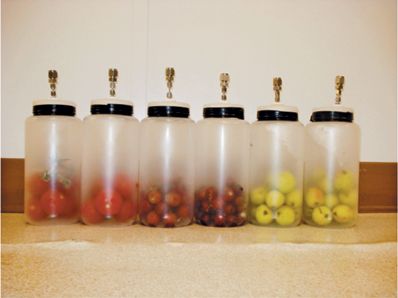
Figure 2: A picture of the sampling vessels.
For the characterization of entrenched ethylene in industrial solvents, the industrial solvents were obtained on site. The samples were prepared by total evaporative technique using 20 μL of solvent in a 250-mL serum vial and heating them to 80 °C.
Results and Discussion
The performance of the analytical system was optimized for best separation with the shortest time possible to enhance sample throughput. We determined 130 °C as the optimal temperature for the GC oven and used this temperature for all subsequent experiments. Under these conditions, ethylene is eluted at 84 s and total analysis time is 4 min. Figure 3 shows an overlay of chromatograms ranging from 10 to 1000 ppb (v/v) of ethylene in air under the conditions described. Six moles of mercury vapor are generated for each mole of ethylene, leading to the high sensitivity and selectivity of the detector.
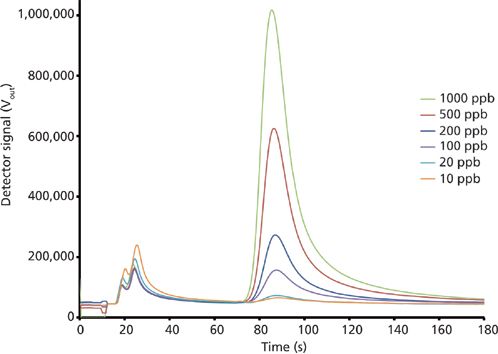
Figure 3: An overlay of chromatograms ranging from 10 to 1000 ppb (v/v) of ethylene in air.
Determination of Ethylene in the Fruit-Ripening Process
A study was conducted with climacteric fruits such as apples and tomatoes, which continue to ripen after being harvested. Grapes, a nonclimacteric fruit that only ripens while still attached to the plant, were also used in this experiment (18). The emission of ethylene from these matrices can be monitored using the simple sampling device. The frequency of sampling and the amount of sampling have a direct impact on the duration of the study. In general, if the vessel is pressurized to 6 psig, with the removal of approximately 10–20 mL/day, there is a sufficient volume to satisfy a sampling period of seven days.
Figure 4 shows a plot of the amount of ethylene generated per gram of fruit by various matrices over the course of 168 h. Over this seven day period, tomatoes generated the most ethylene per day, increasing to a maximum concentration of approximately 16.5 ppb (v/v) per gram. Apples reached a maximum level of ethylene production at 8 ppb (v/v) per gram of fruit at about 48 h and then leveled off for the remainder of the study. Grapes had a steady increase in ethylene for the duration of the study. The rate of ethylene generation of the tomatoes and grapes increased significantly after approximately 50 h, with a substantial amount of mold visible on the tomatoes and grapes. The rate of increase of ethylene might have been caused by a mold such as Passalora fulva that can accelerate the decomposition process on tomatoes or other uncontrolled factors like bacteria growth such as Xanthomonas ampelina, which is common in grapes. No forensic work was conducted to ascertain the type of mold observed. In contrast, mold was not visually observed on the apples. Regardless, our results show that the analytical procedure developed with the novel sampling vessel described can be an effective means of monitoring the fruit ripening process by measuring the net emission of ethylene; that is, the difference in the rate of emission and the rate of absorption of the matrix in a sealed container.
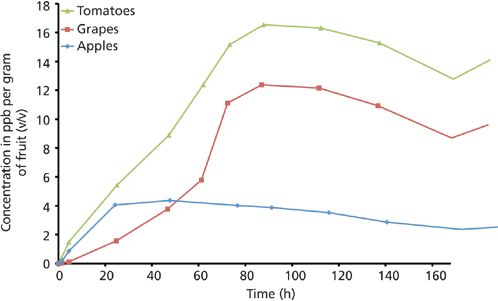
Figure 4: A plot of the amount of ethylene generated by various matrices over the course of 168 h (seven days).
Determination of Ethylene in Air
Ethylene in ambient air can be studied very accurately with the procedure described. This finding is consistent with results that have been reported in the literature (19,20). As a demonstration of the capability of the analytical system, two sources of air (Shanghai, China, and Folsom, California) were obtained from inflatable cushioning packages that are commonly used to protect fragile items during shipment, and ambient air in Edmonton, Alberta, Canada, was collected. It was found that the concentration of ethylene in these locations was 63, 10, and <10 ppb (v/v), respectively. Figure 5 shows an overlay of the results obtained. It should be noted that the level of ethylene in ambient air varies from day to day depending on industrial activities, wind velocity, and temperature. Additionally, ethylene has a half-life of 2.2 days.
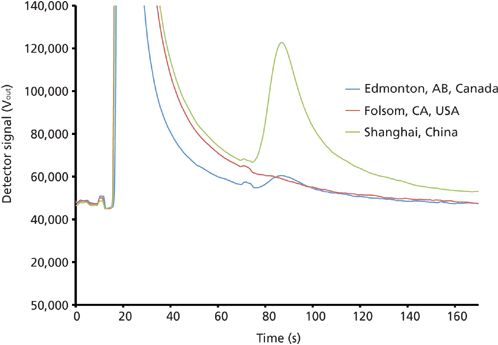
Figure 5: Overlay of chromatograms of ethylene in air from three different locations.
Determination of Ethylene in Industrial Solvent
Ethylene is soluble in a variety of polar and nonpolar process solvents at atmospheric temperatures and pressures. The presence of ethylene in industrial solvents can have a negative impact on the flammability of chemical processes, particularly in chemical and petrochemical operations (21–23). Also, the recovery of ethylene from a chemical process can improve economic profitability since ethylene is a feedstock in many chemical processes. Figure 6 shows a plot of entrenched ethylene in commercially available industrial solvents. The concentration of ethylene detected ranged from 13 to 330 ppb (v/v), which demonstrates the high degree of selectivity and sensitivity of the analytical technique.
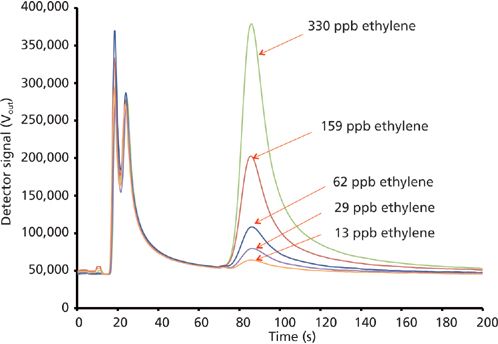
Figure 6: Overlay of chromatograms of entrenched ethylene in commercially available industrial solvents.
Conclusions
We successfully developed and implemented a GC approach using short packed columns and RGD for the characterization of ethylene in a variety of matrices, notably in tracking the presence of ethylene in the fruit-ripening process, in ambient air, and in industrial solvents. Ultratrace detection of ethylene in various matrices was conducted without sample preconcentration. The approach has a high degree of reliability and is easy to maintain and operate when compared to other methods for trace ethylene analysis. This technique has the potential for use in other volatile gas applications where the analytes of interest can be reduced with mercuric oxide.
Acknowledgments
Monica Lin was supported by the Visiting Scholar Program at the Dow Chemical Company in Alberta Operations. We acknowledge Dr. Martine Stolk of Dow Analytical Technology Center, Mr. Joe Deutscher of Dow Alberta Operations, and Alexander Lowe of Peak Laboratories for their support and encouragement. This project was partially funded by the Analytical Technology Center's Technology 2014 Renewal and Development Program. Peak Laboratories is gratefully acknowledged for the use of the GC system.
References
(1) X.L. Cao, C. Hewitt, and K. Waterhouse, J. Chromatogr. A679, 115 (1994).
(2) X.L. Cao, C. Hewitt, and K. Waterhouse, Anal. Chim. Acta300, 193 (1995).
(3) M. Succi and J. Moncur, Process Anal. Chem. 57, 2287 (1991).
(4) C. Ostrander, US patent 4,411,867, October 25, 1983.
(5) C. Ostrander, D. Oharra, C. McDowell, and S. Hartmann, US patent 6,368,560, April 9, 2002.
(6) M. Doizaki and M. Levitt, J. Chromatogr. A285, 210 (1984).
(7) T. Kawano, N. Tsuboi, H. Tsujii, T. Sugiyama, Y. Asakura, and T. Uda, J. Chromatogr. A 1023, 123 (2004).
(8) T. Kawano, N. Tsuboi, H. Tsujii, and T. Uda, J. Chromatogr. A1157, 408 (2007).
(9) B. R. Glick, FEMS Microbiol. Lett.251, 1 (2005).
(10) Alberta Environment, "Assessment Report on Ethylene for Developing Ambient Air Quality Objectives" (2002).
(11) D. O'Hara and H. Singh, Atmosph. Environ.22, 2613 (1985).
(12) X.L. Cao and C. Hewitt, J. Chromatogr. A648, 191 (1993).
(13) F. Abeles, Ethylene in Plant Biology (Academic Press, New York, 1973).
(14) M. Saltveit and S. Yang, Principles and Practice of Plant Hormone Analysis, Vol. 2 (Academic Press, New York, 1987), pp. 367–401.
(15) R. Young, H. Pratt, and J. Biale, Anal. Chem.24, 551 (1952).
(16) E. Butrym and T. Hartman, "Determination of Ethylene by Adsorbent Trapping and Thermal Desorption - Gas Chromatography," Application note 65, Scientific Instrument Service (1999).
(17) B.E. Taylor, G.M. Silver, and R. Fall, Atmos. Environ.27A, 2689 (1993).
(18) C. Chervin, A. El-Keramy, J.P. Roustan, A. Latche, J. Lamon, and M. Bouzayen, Plant Sci.167, 1301 (2004).
(19) F.B. Abeles and H.E. Heggestad, J. Air Waste Manage. Assoc. 23, 517 (1973).
(20) M.S. Aziz and A.J. Orr-Ewing, J Environ. Monit.12, 3094 (2012).
(21) H. Lin and B.D. Freeman, J. Membr. Sci. 239, 105 (2004).
(22) A. Sahgal, H.M. La, and W. Hayduk, Can. J. Chem. Eng.56, 354 (1978).
(23) Y. Sato, N. Hosaka, H. Inomata, and K. Kanaka, Fluid Phase Equilib.344, 112 (2013).
Monica Lin is a student at McGill University in Montreal, Quebec, Canada. Ronda Gras is an Associate Manager with Dow Chemical Canada ULC in Fort Saskatchewan, Canada. Clayton Bleile is the president of ChromeEnterprise in Edmonton, Canada. Kaelyn Gras is a student at the University of Alberta in Edmonton, Alberta, Canada. Jim Luong, PhD, is an Associate Technology Director with Dow Chemical Canada ULC and the Australian Centre for Research on Separation Science (ACROSS) at the University of Tasmania in Tasmania, Australia. Robert A. Shellie, PhD, is an associate professor with the Australian Centre for Research on Separation Science (ACROSS) at the University of Tasmania. Direct correspondence to: Robert.shellie@utas.edu.au

New Study Reviews Chromatography Methods for Flavonoid Analysis
April 21st 2025Flavonoids are widely used metabolites that carry out various functions in different industries, such as food and cosmetics. Detecting, separating, and quantifying them in fruit species can be a complicated process.
Quantifying Terpenes in Hydrodistilled Cannabis sativa Essential Oil with GC-MS
April 21st 2025A recent study conducted at the University of Georgia, (Athens, Georgia) presented a validated method for quantifying 18 terpenes in Cannabis sativa essential oil, extracted via hydrodistillation. The method, utilizing gas chromatography–mass spectrometry (GC–MS) with selected ion monitoring (SIM), includes using internal standards (n-tridecane and octadecane) for accurate analysis, with key validation parameters—such as specificity, accuracy, precision, and detection limits—thoroughly assessed. LCGC International spoke to Noelle Joy of the University of Georgia, corresponding author of this paper discussing the method, about its creation and benefits it offers the analytical community.














